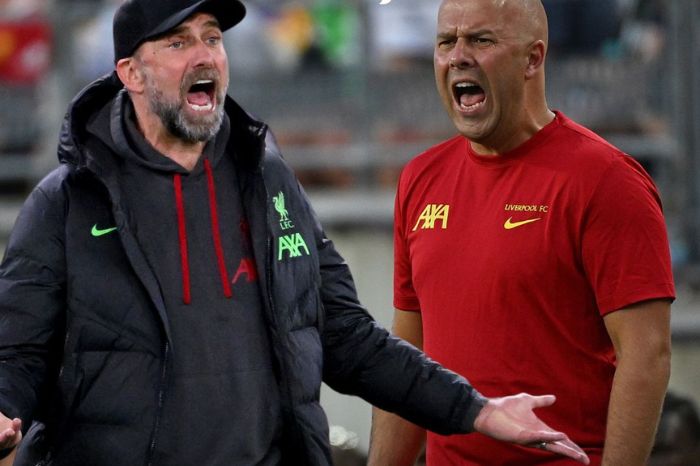The arrival of Arne Slot at Liverpool has signalled a stylistic shift in the club’s approach to football. Known for his “elegant” Dutch style, Slot’s methods are set to contrast significantly with the high-octane, “heavy metal football” that Jurgen Klopp popularised during his tenure at Anfield. Here are the five main differences between the two managers’ styles of play:
Click HERE to bet on Liverpool winning the English Premier League this season!
1. Elegance Over Intensity
Jurgen Klopp’s Liverpool was synonymous with intense, high-energy football that emphasised relentless pressing, quick transitions, and physicality. Dubbed “heavy metal football,” Klopp’s approach often felt like a barrage of attacks that overwhelmed opponents through sheer pace and power. In contrast, Arne Slot is bringing a more measured, possession-based approach that Harvey Elliott described as “very elegant” and more traditionally Dutch. Slot’s emphasis is on maintaining possession, building up play with composure, and employing fluid, methodical patterns that prioritise control over chaos.
2. Tactical Flexibility and Structure
Klopp’s Liverpool team was largely built around a 4-3-3 formation, which emphasised high pressing from the front three and dynamic runs from the midfield to support the attack. Klopp’s system often relied on the full-backs pushing high up the pitch, leaving space behind them covered by industrious midfielders. In contrast, Slot has been known to employ a 4-2-3-1 formation that shifts into a 4-4-2 when pressing. His use of a double pivot provides more structural support in midfield, allowing for better coverage across the pitch and a more disciplined approach to defending, particularly when the team loses possession.
3. Emphasis on Positional Play
While Klopp’s style relied heavily on the physical attributes and pressing ability of his players, Slot focuses on positional play, where players maintain a disciplined structure to control the game. At Feyenoord, Slot’s teams were known for their ability to dominate possession, patiently working the ball through the lines before attacking with precision. This shift in focus means that Liverpool under Slot may see less of the frenetic pressing and more deliberate, orchestrated movements designed to unbalance opponents and create space through intelligent positioning rather than sheer athleticism.
4. Inverted Full-Backs and a Double Pivot
Klopp’s full-backs, particularly Trent Alexander-Arnold and Andy Robertson, were central to Liverpool’s attack, often operating as auxiliary wingers. In Slot’s system, however, full-backs might be used differently, particularly with the inversion of a full-back into a midfield role to create a double pivot. This tactic, which Slot employed at Feyenoord, helps to maintain defensive solidity while allowing the midfield to control the tempo of the game. The result is a more controlled, possession-oriented build-up, in contrast to Klopp’s direct and expansive play that frequently exposed the flanks.
5. Attacking Movements and Numbers in the Box
Under Klopp, Liverpool’s attack was characterised by quick, aggressive movements aimed at overwhelming defenses, with the front three often supported by overlapping full-backs and late runs from midfielders. Slot’s approach, however, sees a more calculated attack, with multiple players working in unison to create opportunities. His Feyenoord teams frequently committed four or five players into the box, but only after carefully constructing the play to exploit defensive weaknesses. This contrasts with Klopp’s more chaotic and direct method, where attacking chances were often created through high pressing and rapid counters.
Join our exclusive Telegram channel HERE for hourly booking codes and news!
How will Slot get on at Liverpool? Comment below with your views!



